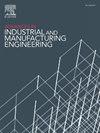用一种新型的对角-十字形试样表征板材的成形性极限
IF 6
Q2 ENGINEERING, INDUSTRIAL
Advances in Industrial and Manufacturing Engineering
Pub Date : 2025-09-11
DOI:10.1016/j.aime.2025.100171
引用次数: 0
摘要
本文介绍了一种创新的对角-十字形试样,显著提高了板料成形极限的表征。试件独特的设计特点是网状的二维几何结构,四个三角形臂在中心连接,在单轴加载时有效地诱导双轴拉伸应力状态。此外,在其中心加入加工球形杯以局部减少厚度,确保了该区域的损伤积累。使用数字图像相关(DIC)捕获实验应变加载路径,并使用专门用于材料成形性研究和教育的内部软件进行分析。该软件在主应变空间中识别并绘制了颈缩和断裂的起始点,结果证明,对角-十字形试样在C11000铜片中产生稳定的双轴拉伸应变加载路径是非常有效的,在不依赖摩擦的条件下运行,无需专门的测试设备。随后,通过将断裂极限与单点增量薄板成形部件直至失效的应变加载路径进行比较,验证断裂极限。该研究证实了用于评估C11000铜片可成形性的新型对角-十字形试样的通用性和稳健性,并为其在更广泛的板材可成形性表征领域的潜在应用提供了有价值的见解。本文章由计算机程序翻译,如有差异,请以英文原文为准。
Characterization of sheet formability limits using a novel diagonal-cruciform test specimen
This paper introduces an innovative diagonal-cruciform test specimen that significantly enhances the characterization of formability limits in sheet metal forming. The specimen's unique design features a reticular two-dimensional geometric structure, with four triangular arms connecting at the center, which effectively induce biaxial tension stress states when subjected to uniaxial loading. Furthermore, the incorporation of machined spherical cups at its center to locally reduce thickness ensures that damage accumulates in this region. Experimental strain loading paths are captured using digital image correlation (DIC) and analyzed with in-house software developed specifically for research and education on material formability. The software identifies and plots the onsets of necking and fracture in principal strain space, and results prove that the diagonal-cruciform specimen is highly effective in generating stable biaxial tension strain loading paths in C11000 copper sheets, operating under friction-independent conditions without the necessity for specialized testing equipment. The fracture limits are subsequently validated by comparing them against the strain loading paths obtained from a single-point incremental sheet-formed part up to failure. The investigation confirms the versatility and robustness of the novel diagonal-cruciform test specimen for evaluating the formability of C11000 copper sheets and provides valuable insights into its potential application across the broader field of sheet formability characterization.
求助全文
通过发布文献求助,成功后即可免费获取论文全文。
去求助
来源期刊

Advances in Industrial and Manufacturing Engineering
Engineering-Engineering (miscellaneous)
CiteScore
6.60
自引率
0.00%
发文量
31
审稿时长
18 days
 求助内容:
求助内容: 应助结果提醒方式:
应助结果提醒方式:


